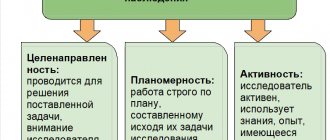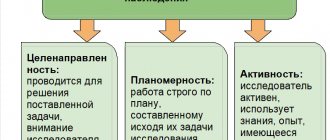Psychological observation: definition of the concept
Observation in psychology is one of the main methods of knowing the characteristics of an object empirically. The method requires a mandatory transition from describing facts to explaining their essence, forming a psychological characteristic of what is being observed.
The results of applying the scientific method can be influenced by the following factors:
- level of knowledge in the area under study;
- professional experience, qualifications of the observer;
- personal experience, emotional and mental stereotypes, value orientations of the psychologist.
Observation presupposes the non-interference of the subject in the process or situation under study.
The method makes it possible to get a complete picture of what is happening and reflect it through records and tables. A special feature of the procedure is the complexity, and often the impossibility, of accurately repeating the observation situation.
general information
The main subject of study of the science of psychology is the intangible component, the human psyche.
It is a complex system with many levels, connections and mutually influencing components.
This system is constantly in an active state and is exposed to external influences, so it can be very difficult to predict the development of certain psychological changes.
Therefore, the leading methods in psychology are observation and experiment.
Observation is a set of descriptive techniques that record the state of an object over a certain time.
For this description, certain sets of characteristics are formed: character traits, types of temperament, the nature of the psychological reaction, and the like.
For a more comprehensive approach, the use of experiment . This method is a psychological “experience”, which is also based on the use of this tool in the process of constructing this experience.
An experiment is most often used in conjunction with an observational method, which ensures the most complete collection of information.
The essence of the method
Observation in psychological science, unlike everyday observation, is based on a specific plan, a program thought out in advance, and requires recording facts, their analysis and interpretation.
Only external (speech, motor) manifestations are available for tracking. For example, it is impossible to observe:
- intelligence, but the researcher can monitor the process of solving problems;
- sociability, but you can see the fact of communication with other people.
Observed situations, phenomena, and behavior of objects are necessarily recorded in protocols and diaries. The observed characteristics are presented as descriptively as possible, without explanation. The form of the protocol reflects the subject, task, hypothesis and main criteria of the study.
The reliability of observation results increases if the researcher has the opportunity to use the method for a long time, to observe objects in different situations and roles. The reliability of the study also increases if several observers monitor the situation.
Qualitative observation is only possible if there are no role relationships between object and subject. For example, a schoolchild behaves differently in the presence of parents, teachers and friends. Therefore, the characteristics that different people give it differ.
Psychological observation does not allow the subject to intervene in the situation being studied. The observation results are necessarily supported by data from other research methods.
Where is it used?
The observational method has the widest application in scientific and everyday activities. It is used for :
- descriptions of the current psychological situation in the team,
- analysis of basic personality characteristics,
- conducting an experiment to obtain descriptive data,
- independent use within the framework of self-observation,
- behavior control,
- monitoring the effectiveness of therapy or correction techniques,
- obtaining a database for drawing up a scientific or scientific hypothesis,
- processing the results of psychological research.
The variety of possible uses unifies this method, which is used in all sections: from occupational psychology to Gestalt therapy.
Object and surveillance equipment
The objects of observation are individual people or many participants at once. They may belong to the same or different social groups. The subject of observation is the behavior of those being watched:
- verbal manifestations - content of conversations, intensity, duration of speech, expressiveness, vocabulary, grammatical structures;
- non-verbal manifestations - facial expression, direction of gaze, eye movements, facial expressions, gestures;
- movement - maintaining or not maintaining a distance, speed of movement or state of immobility;
- physical influence on others - blows, pushes, touches, joint efforts.
Only that which can be registered becomes the object of observation. While tracking an object, the researcher does not observe his own mental reality, but records those facts that he sees and can record. The psyche is manifested in behavior - this postulate allows the researcher to make assumptions about the mental properties of an object. The basis for the hypothesis is observational data.
The means of observation can be either the researcher himself or the auxiliary elements chosen by him:
- sound recording equipment;
- video and photo camera;
- special observation maps.
The choice of equipment for recording the situation is determined by the conditions in which it is carried out - in an isolated room, in a public place.
Subject of study
Depending on the goals of the study, the subject can be different objects. These include:
- Behavioral reactions of the individual and the team . These reactions can be observed both in interaction and by isolating specific ones for analysis of subjective reactions.
- Psychological verbal and nonverbal communications: verbal contact, facial expressions, emotional reflection. All these signals form a psychological portrait, which can also be the subject of observation.
- Patterns of human interaction . This includes conflicts, ways to resolve them, options for communication within the team, identifying the leader and the outsider. The subject in this case is communicative forms of behavior and mental characteristics that allow their implementation.
- Personal characteristics. When tracking an individual individual, the subject of research will be his mental activity and behavioral characteristics.
Psychological observation: applied classification
In psychology, the observation method is used in cases where the researcher needs to obtain information about the behavior of a specific person or group of people in the most natural conditions for them, without interfering in the situation. The observation itself should not in any way affect the natural development of events.
There are several types of psychological observation:
- laboratory;
- field (in natural life conditions);
- explicit;
- hidden;
- indirect;
- indirect;
- included (open or closed type);
- not included;
- direct;
- indirect;
- solid;
- selective.
During continuous tracking, the researcher records all the nuances and signs of the object’s mental activity over a certain period of time. In selective research, only those manifestations that directly or indirectly relate to the topic being studied are taken into account.
The classification also includes the concept of systematic and non-systematic observation. In the first case, the research is carried out in accordance with a clearly defined plan. The observer records behavioral characteristics, registers and classifies external conditions.
With non-systematic observation, the researcher’s focus is on a generalized picture of the behavior of a subject or group of people in certain external conditions. At the same time, the goal is not to record the causes of behavioral manifestations, analyze their relationship and strictly describe the phenomena.
Field observations are carried out in natural conditions for an object or group. The main requirement is the researcher's non-interference in the situation. Observation in natural conditions makes it possible to study the behavior of an object without significant distortions. But the problem with conducting such research is that it is labor intensive, and also that the researcher cannot control the situation. Field surveillance is often unsystematic and is carried out using a wait-and-see approach.
Laboratory tracking is more convenient for the researcher, but the artificial environment may not have the best effect on the results of the study.
According to the duration of the study, they are distinguished:
- longitudinal - carried out over a long time (several years, decades), involves constant contact between the researcher and the object of study. The result of the observation is recorded in diaries, representing as widely as possible the behavior, lifestyle, habits and other manifestations on the part of the object;
- Periodic is the most common type of chronological tracking structure. It is carried out over several short periods of time.
Single, one-time observations - they are presented as a description of individual cases. Research is unique in nature, but can also be represented by already known manifestations of a psychological process or phenomenon.
Based on the forms of research, a distinction is made between conscious and unconscious, internal and external observations.
Unconscious internal psychological observation
This type of surveillance is characterized by the fact that the target is unaware that he is being monitored. The researcher himself becomes part of the situation. For example, psychologists often infiltrate a specific company in order to study in as much detail as possible the behavioral characteristics of its participants. During the study, the observer comes into close contact with the object or their group, but the subjects are not aware of the purpose of the interaction.
The method of unconscious internal observation is often used to study the characteristics of small social groups. The psychologist's natural behavior contributes to successful research. If this condition is met, work in a group does not affect the course of the study and the behavior of its participants.
Ethical issues can complicate the job. During tracking, difficulties may arise with audio and video recording, especially considering that the recording of the results must occur in secret from the participants.
The observation itself does not influence the subject's behavior as prescribed by the protocol. He receives the maximum amount of useful information if he can establish direct contact with the subjects being studied. But another problem may be that the psychologist begins to share the moral values of the subjects being studied, and the specialist experiences a moral conflict.
Conscious internal psychological observation
Conscious internal observation is characterized by the fact that the subject knows that he is being watched. The researcher comes into contact with the observed, even before starting work, introduces him to the task at hand, and talks about his status.
Sometimes the subject is given incorrect information. This is done to make it possible to record the characteristics of behavior in a specific situation. Such actions by researchers contradict the requirements of the ethical code and threaten serious punishment, and the experiment often has an unfavorable outcome. The situation itself creates stress for the observed, and its consequences can negatively affect his future life.
External type
The main condition for carrying out external unconscious observation is that the observed person does not know that he is being tracked. The psychologist does not come into contact with the object or the group being studied, but only records the information received, being in a detached position.
Thus, doctors in psychiatric clinics monitor patients through a small window. From the doctor's side it is transparent, but the patient sees a mirror instead of a window. This feature of the tracking organization makes it possible to observe the actions of objects without constraining or embarrassing them.
During external observation, it is possible to collect maximum objective information about the object, its behavior or mental manifestations. The advantage of such observation is that a tired researcher can be replaced by another, and it also becomes possible for several specialists to take part in the experiment at once.
In external research, the situation unfolds naturally, without pressure from the outside; the specialist has the opportunity to use technical means to record facts.
Example
A good example of such work in psychology is preliminary and periodic psychological testing of employees .
They make it possible to monitor both the professional suitability of the employee and his deformation during work activities.
Such surveillance is actively used in the military and law enforcement fields.
Another example is drawing up a psychological portrait of a person when seeking appropriate help. In this case, the method is one-time, based on descriptive information and reflects the state of a person at the current moment.
Psychological observation: advantages and disadvantages
The advantages and disadvantages of a research method such as observation should be assessed in advance, at the planning stage.
The positive aspects of observation include the opportunity to:
- identify the smallest details of the issue under study, reveal its versatility;
- see and record events and behavioral manifestations directly during their occurrence;
- maintain contact between the observer and the subject, which allows you to obtain the most reliable, objective and relevant information of a social nature;
- fully understand the motives and meaning of certain behavioral manifestations in different situations, identify their impact on current events;
- maintain the researcher’s independence from the observed object, when collecting information, rely not only on the ability, but also the desire to establish contact.
Observation is a relatively inexpensive empirical method. It allows you to quickly obtain the necessary information. The study is easy to organize regardless of the willingness of one or a group of objects to participate in it.
Disadvantages of psychological observation are divided into 2 groups - objective, independent of the observer, and subjective. They are associated with personal characteristics, professional qualities of the researcher, as well as the attitudes of the experiment participants.
The objective disadvantages of observation in psychology include the following:
- the inability to use tracking often enough when it is necessary to involve a large number of people being observed;
- a limited number of studied processes and related mental phenomena, which leads to a narrowing of the ability to widely generalize the results obtained;
- the difficulty, and often impossibility, of completely repeating the study;
- the ability to draw only qualitative, but not quantitative conclusions;
- frequent occurrence of difficulties with recording and describing the phenomena under study, the need to do this part of the work after the end of the observation;
- insufficient opportunity to obtain information about the goals and reasons for recorded behavior;
- temporary limitation on the time of unfolding of the event;
- the labor-intensive nature of the method, often the need to involve a large number of highly qualified specialists in the research;
- high cost in the case of using special sound and video recording equipment.
Psychologists believe that another disadvantage of observation is that the method does not allow one to directly examine all the facts; many areas are inaccessible for research in this way.
Among the subjective disadvantages:
- the researcher's ability to influence the situation;
- the risk of introducing a subjective opinion or attitudes during the interpretation of the received material, which entails an incorrect interpretation, a discrepancy between the obtained result and the real situation;
- unequal social status, cultural differences, dissimilarity in behavioral stereotypes and life positions of the researcher and the subject can affect the interpretation and distort the result;
- The researcher’s personality traits may affect his perception of the observed situation, which reduces the quality and reliability of the method. For example, if a specialist develops a feeling of condescension towards an object, it is possible to obtain an exaggeratedly positive result. If a psychologist is unconsciously inclined to see the contrast of the participants in the experiment, then he can ignore their characteristic character traits and behavioral manifestations and notice only those that coincide with his perception.
At a certain moment, a psychologist can leave the observer’s position and become involved in the situation. This is fraught with the fact that he will lose the opportunity to objectively assess what is happening.
If the researcher, even before the start of the experiment, has a clearly formed opinion regarding the subject of the study, this may cause the formation of a certain point of view on the situation. Expectation often arises if the researcher has had contact with the person being observed before the experiment. In such a situation, a shift in emphasis during observation is possible.
Psychologists may make mistakes during observation. They, like the problems listed above, arise in the absence of personal therapy and supervision from a specialist. The most common mistakes are:
- Averaging is the fear of making an extreme judgment. It is based on the belief that extreme behavioral manifestations are much less common than low- and moderate-intensity ones. Avoiding polar assessments, researchers average them and make the results uniform. Using a wide range of estimates when studying the intensity of behavioral manifestations helps to avoid this. A psychologist prone to averaging needs to identify in himself the reason for excessive indulgence (it can be provoked by self-doubt, poor knowledge of the subject of research).
- Incorrect modeling, in which the researcher uses deduction, is confident that some personality traits are interrelated or contradict each other. Arranging a “logical” conclusion according to the type: a friendly person is good-natured, a good-natured person is trusting or eloquent, an eloquent person is well-educated and educated, an educated person is eloquent, leads to an erroneous result.
The psychologist’s mood during observation can leave an imprint on his perception of the situation, as well as distort the result of the experiment.
The disadvantages of psychological tracking can be overcome by carefully thinking through the program and thoroughly preparing for the work of collecting the necessary information. Monitoring the progress of work by the study organizers also helps to cope with difficulties.
Irina Sherbul
Reinforcement
Reinforcements
is the instant reaction (positive or negative) of the researcher (or the environment) to the actions of the subject. The reaction must actually be instantaneous, so that the subject immediately has the opportunity to associate it with his action. If the reaction is positive, then this is a sign that you should continue to do or act in a similar way. If the reaction is negative, then vice versa.
Reinforcement can be of the following types:
- Positive - correct behavior/action is reinforced;
- Negative - incorrect behavior/action is prevented;
- Conscious;
- Unconscious;
- Natural - happens by accident (burn, electric shock, etc.);
- Intentional - conscious action (education, training);
- One-time;
- Systematic;
- Direct;
- Indirect;
- Basic;
- Secondary;
- Full;
- Partial.
Reinforcement is a huge part of human life. It, like suggestion, has been present in her since childhood in the process of upbringing and gaining life experience.
EXAMPLE:
Examples of reinforcement are around us at every step: if you put your hand in boiling water or try to touch the fire, you will certainly get burned - this is negative spontaneous reinforcement. The dog, following some command, receives a treat and repeats it with pleasure - positive intentional reinforcement. A child who gets a bad grade at school will be punished at home, and he will try not to give any more bad grades, because if he does, he will be punished again - one-time/systematic negative reinforcement. The bodybuilder knows that only regular training will give results - systematic positive reinforcement.









